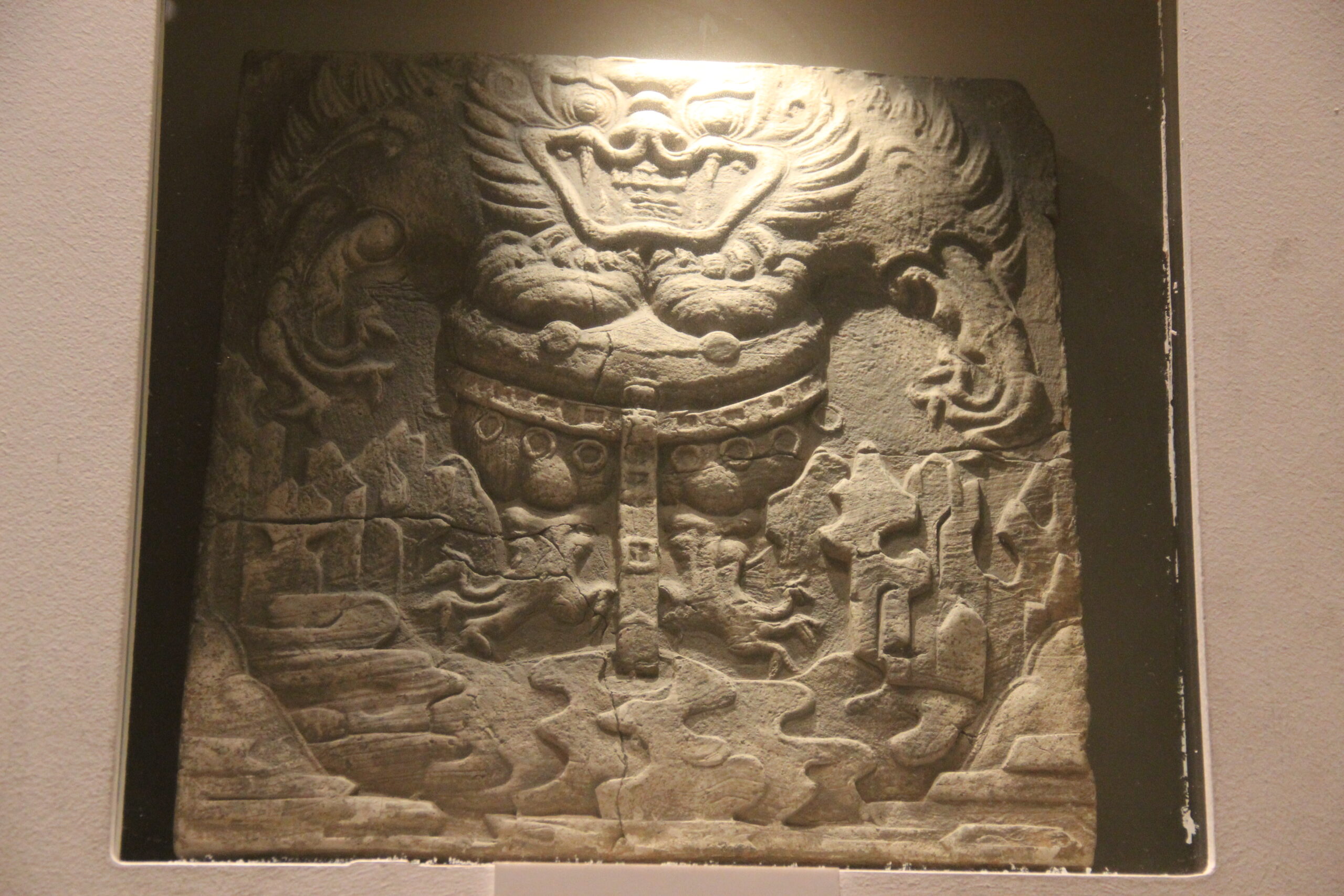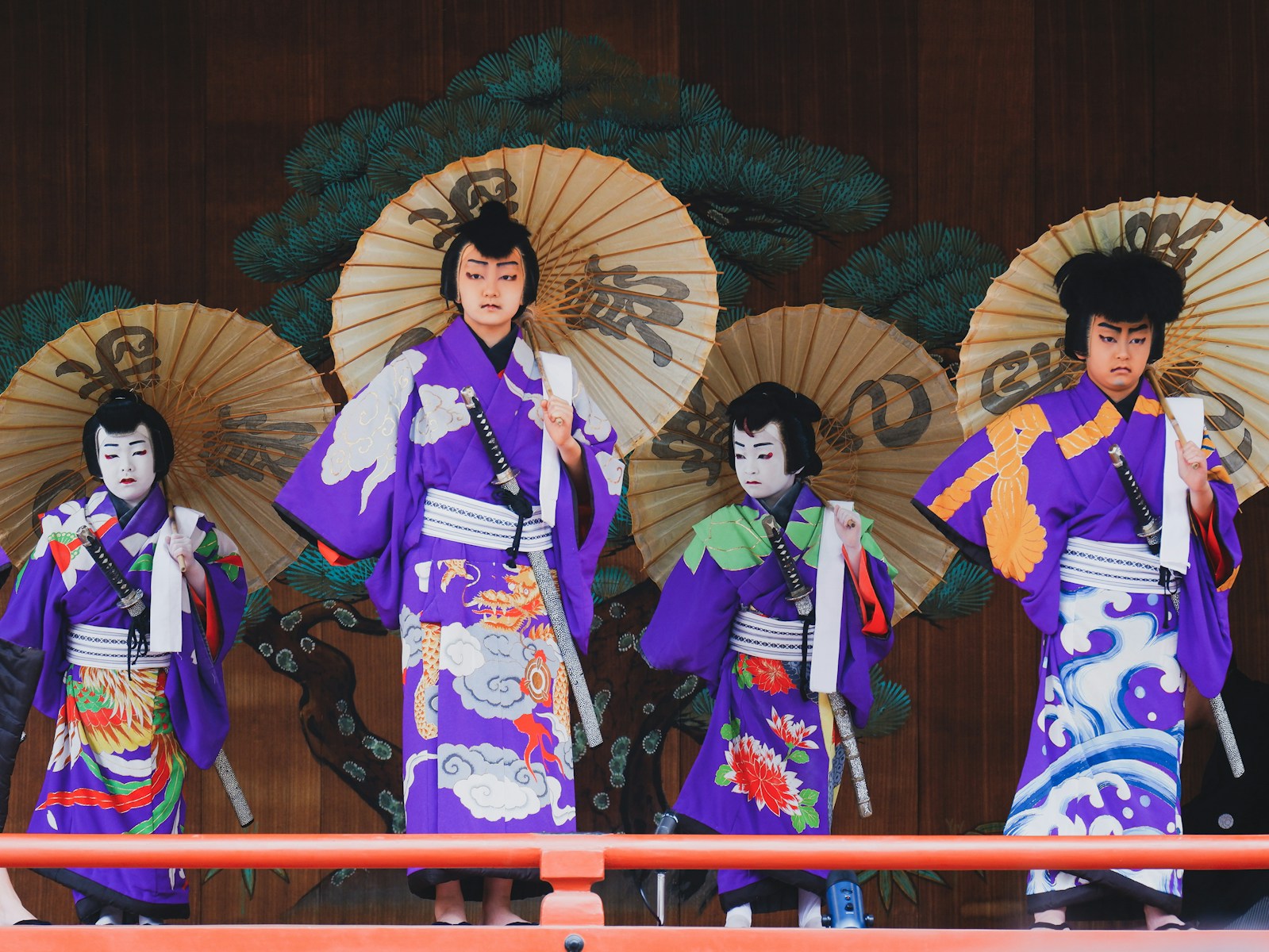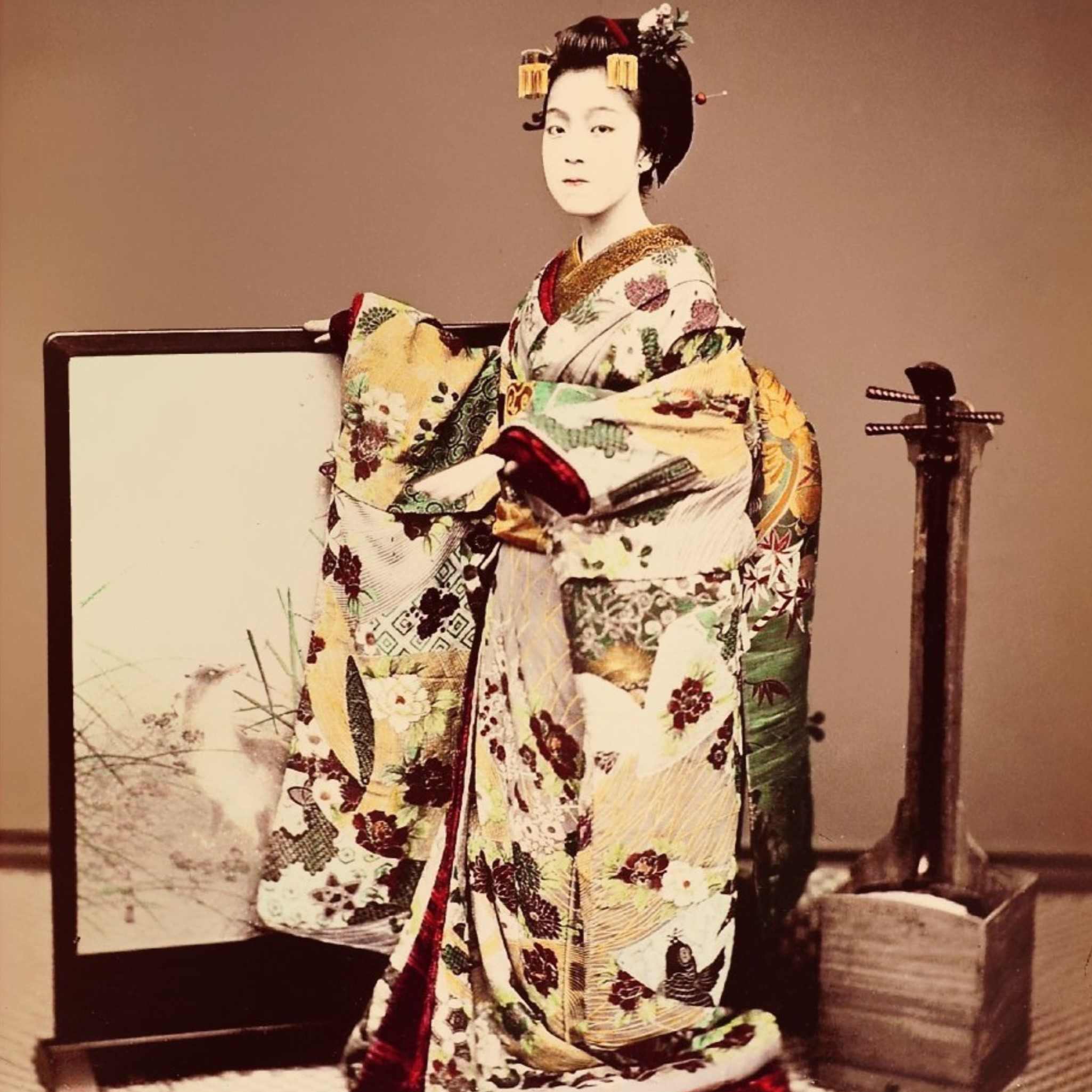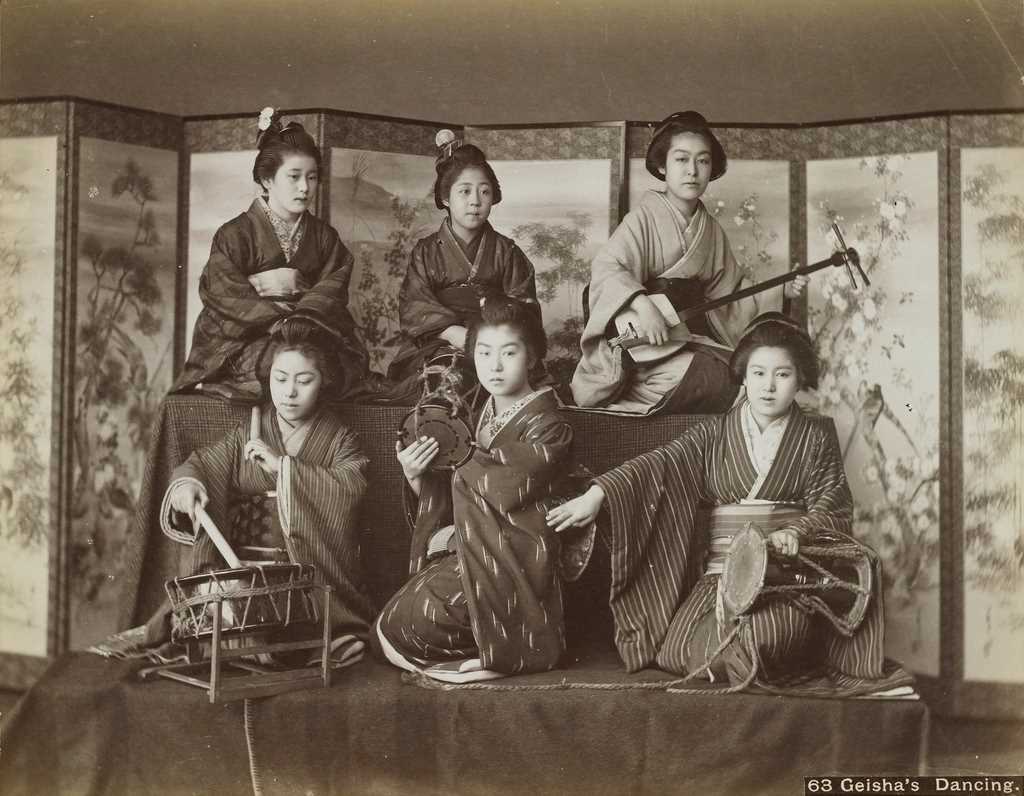The musical landscape of the Japanese archipelago before the Heian period did not appear in isolation. Across a span from Yayoi ritual cultures through Kofun aristocratic consolidation and into the Asuka and Nara courts, sounds, instruments, and ceremonial frameworks arrived first by sea lanes and envoy routes from the Korean peninsula and China, then were repurposed within local practice. What later Japanese sources call gagaku—the court repertory fixed during Nara and Heian—sits on foundations already set by earlier inflows: ritual bronze, immigrant artisans and performers (toraijin), Buddhist chant and masked pageants, and Tang-style instruments and bureaucratic models. This essay maps those pre-Heian layers, distinguishing peninsula- and continent-born elements where the evidence allows, and pointing to archaeological objects and primary or near-primary documentation that readers can consult freely.
Featured image: Baekje Kingdom Pottery Tile
Yayoi and Kofun: bronze signal and choreographed ground
The tall strap-handled bronze bells called dōtaku (ca. 300 BCE–300 CE) remain the clearest early witnesses that sound had ceremonial status. Major museum records point to continental prototypes and cross-sea networks; they place Yayoi casting in dialogue with Korean and Chinese metal traditions rather than in isolation.12 Survey pages at Tokyo and Kyoto museums situate dōtaku within Yayoi rites and material flows.34 The bells do not preserve melodies, but they show investment in sonorous display and public timing.
By Kofun (ca. 300–538), mound complexes and haniwa processional figures indicate organized movement around emerging courts. Even without named instruments, the settings imply wind and percussion with ritual pacing. Those frameworks matter later, because they prepared space for imported models when written sources begin.
Archaeological context also hints at staged sound outdoors: bell hoards appear on slopes above rice fields, and certain specimens show wear consistent with suspension and striking, even if thin-walled casting limited sheer volume. If we read the distribution as a performance map, it suggests periodic assemblies and coordinated ringing across communities that already linked sound to authority and seasonal cycles. That habit of sounding space—open air, processional routes, thresholds—later meets imported repertoires that require ordered entrances, measured tempo, and marked cadences.
Mid-sixth century transfers: Buddhism and chant
In the mid-500s, Buddhism enters through Baekje embassies. Classical narratives differ on the year—538 in one tradition, 552 in the Nihon Shoki—but both point to peninsular mediation delivering icons and texts to the Yamato court.56 Public primers also track the discussion for general readers.7 With Buddhism came shōmyō chant, cultivated in Japanese temples by late Asuka/early Nara; guides and recorded notes outline phrasing, pitch sense, and liturgical function as part of a continental tradition adapted locally.89
Early chant training formed around textual clarity and breath organization. Recitation cadence tracked syllable weight and Chinese-derived prosody, while responsorial patterns fixed roles for a precentor and a chorus. As monasteries grew, chant furnished a portable technique: pupils could move between temples and retain shared cues for beginnings, flex points, and endings. That portability matters for court because it supplied a pool of literate singers who could serve at state rites and memorials alongside instrumental ensembles.
Temple acoustics influenced chant shape. Stone courtyards, timber halls, and thick plaster create a soft decay; phrases lengthen slightly to allow consonants to settle, and unison begins to function as timbre rather than absolute pitch. These same acoustics later prove friendly to court winds, which exploit reverberation to fuse shō clusters with double reed lines.
Gigaku: a masked pageant with peninsular links
Another Asuka-era import is gigaku, a masked procession tied in sources to Mimashi of Baekje, who studied performances in Wu (China) and introduced them in 612 under Empress Suiko. The pageant appears again at the 752 consecration of the Great Buddha at Tōdai-ji.10 Surviving wooden masks in national repositories anchor the narrative and allow close study of role types and carving practice.11
Descriptions emphasize a slow-moving cortege built from stock figures—foreign envoys, monks, guardians, and comic types—framed by drums and double reeds. Even if the full score is lost, the masks show how character movement and musical punctuation locked together. The procession expanded the sonic palette outdoors and created a precedent for hybrid ceremonial programming in which imported pieces alternated with native offerings.
Because gigaku ran as a procession, it taught organizers to manage long, linear stages: gates, cloisters, and temple forecourts. That practical lesson carries into court dance, where entrances and exits become musical events, and drum signals act as stage management as much as rhythm.
Nara frameworks: ritsuryō law and a music bureau
With the Taihō Code (701) and the move to Nara (710), the state created a court music bureau, the Gagakuryō, within ritsuryō administration. Teaching pages describe how the bureau trained performers and mounted music for court and shrine, including indoor kangen (wind-string) and bugaku (dance).12 A durable classification divides repertories by perceived provenance: a “Left” track (tōgaku) linked to Tang-style sources from China, and a “Right” track (komagaku) linked to the Korean peninsula. Program notes for international audiences summarize that split and its consequences for scoring and choreography.13 Public overviews from the Imperial Household Agency set out the court genres in which these ensembles played.11a
Sources also point to hereditary lines that maintained repertory lists, rehearsal discipline, and repair knowledge for instruments and costumes. Within this studio system, apprentices absorbed fingering schemes, breathing plans, and dance grids as part of an administrative calendar. The bureau’s paperwork—appointments, promotions, ceremonial schedules—made music legible to the state and repeatable across reigns.
The Yōrō Code (718) refined parts of the administrative map. Even if many clauses concern taxation and ranks, the implication for musicians was concrete: posts, stipends, and training seats could be expected and contested. That predictability encouraged families to specialize across generations, preserving repertory and workshop skills such as reed making, pipe tuning, and costume care.
Instrument families: continental pedigrees, Japanese functions
Shō. The mouth organ shō belongs to the wider sheng family across East Asia. Reference articles cover the lineage, and museum records document court objects. Performer-facing pages explain the aitake chord clusters and how chord changes (te-utsuri) articulate phrases in kangen and bugaku contexts.141817
The standard instrument mounts seventeen pipes; some are intentionally silenced to shape available chords. Players cycle breath to sustain stacked tones, releasing and resetting clusters as the main melody moves. That sustained haze gives court winds a distinct surface and makes the hichiriki line sound as if it were floating inside a fixed parish of harmony.
Instrument makers adjust pipe length by tiny cuts and varnish layers; a few tenths of a millimeter changes how an aitake sits against the reed chorus. The workshop craft here is consequential: tuning balances must favor ensemble blend over solo projection, because the shō acts as an aural backdrop that locks the band together.
Hichiriki. The double-reed hichiriki (cylindrical bore, relatively large reed) carries the melodic line in both tōgaku and komagaku. An object record details construction, while repertory/ensemble pages define its role within the wind choir.16192627
Its scale practice favors narrow intervals and slides that lean into the final tones expected in each mode. Breath articulation alternates between a pressed, nasal carrying tone and quick ornaments that cue changes in dance geometry. Because the bore is short, embouchure pressure and reed opening control most of the intonation, and training notebooks emphasize how to recover pitch after ornaments without breaking the line.
Flutes. The transverse ryūteki features in Tang-derived repertories; a museum record anchors size, holes, and dating.15 Alongside it stand the komabue (Right-track, associated with Korean sources) and the kagurabue (shrine use). Instrument sheets and category pages group the three and state the komabue’s Right-track use.2425
In dance, flute lines outline the same final tones as the hichiriki but project more clearly over footfall and drum accents. The komabue, being shorter and brighter, cuts through the denser drum pattern of Right-track ensembles, while ryūteki supports the broader step of Left-track choreographies.
Strings, harps, and plucked color. Short-necked lutes in the pipa/biwa family enter through Chinese models and sit most clearly inside Left-track kangen, where they color the wind choir; dance bands tend to omit them, as repertory guides note.19 The Shōsō-in holdings include rare variants such as five-string gogen-biwa noted in curatorial glossaries, and documentary projects have presented reconstructions for study.10 Nara repositories also preserve traces of the angular harp kugo (konghou), documented in museum programs with historical notes, showing how West- and Central-Asian organology reached Japan via Tang courts.9
Plucked color was not only decorative. In indoor kangen, biwa strokes mark cadential turns and ease breath planning for winds; in rehearsal, the steady pulse of plectrum patterns serves as a metronomic scaffold while the shō shades harmony. Harp traces in the record—whether fragments or iconography—extend this palette further and confirm that East Asian court sound drew on long-distance instruments even when repertory settled locally.
String technique carries signatures of migration: plectra, posture, and left-hand ornaments align with continental habits, yet parts are tailored to Japanese acoustics. Low ceilings and soft floors in certain halls soak up percussive attacks, so parts emphasize resonance and staggered arpeggiation over bare tremolo.
Percussion and ensemble layout. Left-track bugaku bands combine taiko, kakko, and shōkō with ryūteki, hichiriki, and shō; strings join for indoor kangen. Right-track komagaku replaces kakko with san-no-tsuzumi and omits strings. Performer guides and educational pages lay out these contrasts across dance and indoor settings.1912
The contrast is audible: Left-track texture leans toward a suspended shimmer from shō and flute, punctuated by the side-drum kakko. Right-track texture is drier and more pointed, with san-no-tsuzumi leading cues for step patterns. Those differences reinforced the visible split on stage and helped listeners hear provenance as a timbral fact, not only a label in the program.
Pitch frameworks and modal thinking
Theory preserved in Japan deploys Chinese pitch concepts while adapting them to local acoustics and ensemble color. Overviews and performer primers map six modal fields in kangen into two families—ryō and ritsu—and show how finals and ambitus operate in practice.20
In rehearsal language, musicians treat modes as constraints on what the shō may sustain and where the hichiriki may rest. The effect is a set of corridors: each piece moves within a corridor whose walls are made from final tones and characteristic degrees. Rather than key change in a Western sense, color shifts come from changed aitake sets and altered tessitura, which the drum patterns announce in advance.
Modal theory also governs dance geometry. Step size and turn angles settle on pitches that feel like home, and cadential patterns in the drums ratify those homes. This is why experienced listeners can predict an ending several bars early: the ensemble is steering toward a modal gate that dancers and drummers already face.
Korean threads before 794
Peninsular influence enters through migrants and technicians often grouped as toraijin. An open-access synthesis collates archaeology and early records for these communities (c. 800 BCE–600 CE), underscoring how skills and materials traveled from the peninsula into the archipelago.23 In court classification the Right-hand stream, komagaku, is explicitly tied to Korea; its flute even carries the label komabue.2425 Historical dictionaries preserve koma usage for Goguryeo and, by extension, as a prefix marking Korean provenance, which aligns with the classification we see in practice. Gigaku reinforces this link with a Baekje performer credited for the 612 introduction.10
Right-track dance shapes differ from Left-track sets in step size, drum calls, and preferred flute. Where Left-track pieces sweep through longer arcs appropriate to Tang-court pacing, Right-track items tend to accent brisk, squared figures that match the brighter komabue. The split does not erase Japanese invention; rather, it gives performers a staging grammar for contrasting colors within a single evening.
Peninsular craftsmen also mattered as builders. Techniques in lacquer, mask carving, and reed preparation moved with people as much as with books or gifts. That material traffic explains why some instrument parts and costume trims in Nara look continental yet serve distinctly Japanese choreographies.
Chinese currents before 794
From China, the court receives instrument templates (shō, hichiriki, ryūteki, biwa), repertory cores (tōgaku), and administrative models embedded in ritsuryō and the Gagakuryō. The shō sits in the sheng family; the hichiriki traces to the bili/guan; and transverse flutes anchor Tang-derived dance music—details covered in reference and museum materials.141626271512
Transmission ran along diplomatic and scholarly routes: envoys studied on the continent, craftsmen and monks traveled in both directions, and imported instruments arrived with tutors capable of adapting scoring to local halls. The court’s registry gave this traffic durable form by fixing how many players sat on each part, how choreographies were grouped, and how repertory was paired to the calendar.
Embassy traffic also carried notational habits and teaching mnemonics. Even where Japanese practice did not adopt Chinese notation wholesale, musicians borrowed syllables, hand signs, and rehearsal chants to lock in phrase length. Those shared devices sped transmission across language boundaries and let visiting experts coach mixed bands.
Indigenous strands inside the court umbrella
Not all sound at court came from abroad. Native song-dance streams (kuniburi-no-utamai) and the zither wagon (yamato-goto) appear in repertory lists and instrument guides. These run in parallel to Tang- and Korea-linked sets, providing a local layer that Nara and Heian maintain alongside imports.1219
Within ceremonies, these indigenous strands act as tonal homing points. After a sequence of Left-track or Right-track dances, a shrine-derived item tightens the frame to local myth and place. The alternation made sense for audiences who negotiated both imperial identity and regional affiliation; it also kept the evening’s color varied without loosening ritual focus.
Provincial entertainments later labeled as azuma-asobi and military-processional kume-mai show how local movement vocabularies coexist with imported court patterns. Even when repertory titles arrive from abroad, dancers step them with regional accent, and instrument balances shift slightly to suit local halls and weather.
Shōsō-in as repository and witness
For material proof of pre-Heian transfers, Shōsō-in is central. The Imperial Household Agency’s pages outline the repository’s scope and stewardship; the official Shōsō-in portal provides public access routes and exhibitions. Instruments and masks fix the court’s eighth-century instrumentarium and festival practice in wood, silk, and lacquer.2122
Beyond instruments, textiles and small finds chart the visual logic of staging—costume colors, trim, and layout that help date choreographic conventions. When we read those materials alongside the repertory lists, a practical picture forms: rehearsal rooms with annotated parts, storehouses with labeled cases for masks and drums, and a calendar that folded court ceremony, temple consecrations, and diplomatic receptions into a single musical economy.
Scholars use the repository to cross-check oral transmission. Where families remember how a dance enters, an eighth-century mask or flute confirms the likely pace, height of the head, and the practical air needed to carry sound across the stage. Material culture grounds memory without fixing it rigidly; it lets the living tradition tune itself to plausible pasts.
How the pieces fit by 794
By the close of the Nara period, court sound rests on three strands. First, a Chinese strand supplies repertory (tōgaku), instrument families (shō, hichiriki, ryūteki, biwa), and an administrative template (Gagakuryō). Second, a Korean strand defines the Right-hand class (komagaku) and leaves distinct markers—instrument names, dance conventions, gigaku—in staging and terminology. Third, a Buddhist vocal strand sustains liturgical voice and pedagogy in temple networks that overlap with court service. Earlier ritual substrates—Yayoi bronze sound and Kofun processions—prepared the archipelago to receive and reuse these frameworks. Heian refinements later adjust textures and repertory, but pre-794 layers already set the working map.
Notes (Chicago style)
- The Metropolitan Museum of Art, “Dōtaku (Bronze Bell),” The Met Collection, object 44831, accessed August 11, 2025, https://www.metmuseum.org/art/collection/search/44831. Archived: IA capture index.
- British Museum, “dotaku,” object A-1887,1121.11 (Yayoi period), accessed August 11, 2025, https://www.britishmuseum.org/collection/object/A_1887-1121-11. Archived: IA capture index.
- Tokyo National Museum, “Bronze Ritual Implements of the Yayoi Period,” Japanese Archaeology Gallery (Heiseikan), accessed August 11, 2025, https://www.tnm.jp/modules/r_exhibition/index.php?controller=item&id=7816&lang=en. Archived: IA capture index.
- Kyoto National Museum, “Dotaku (Ritual Bronze Bells),” Learn > Dictionaries, accessed August 11, 2025, https://www.kyohaku.go.jp/eng/learn/home/dictio/kouko/45dotaku/. Archived: IA capture index.
- William George Aston (trans.), Nihongi: Chronicles of Japan from the Earliest Times to A.D. 697, vol. 1–2 (London: Tuttle reprint of 1896), Internet Archive edition, accessed August 11, 2025, https://archive.org/details/nihongichronicl00astogoog.
- University of Vienna, “Die Einführung des Buddhismus in Japan,” Religion-in-Japan, accessed August 11, 2025, summary of 538 vs. 552 dates, https://religion-in-japan.univie.ac.at/an/Geschichte/Fruehzeit/Einfuehrung_des_Buddhismus.
- EBSCO Research Starters, “Buddhism Arrives in Japan,” accessed August 11, 2025, https://www.ebsco.com/research-starters/history/buddhism-arrives-japan.
- Japan Arts Council / National Theatre of Japan, “声明(shōmyō)” learning pages within the Cultural Digital Library, accessed August 11, 2025, https://www2.ntj.jac.go.jp/dglib/contents/learn/edc28/shiru/geinou/gagaku.html. Archived: IA capture index.
- Smithsonian Folkways, Japan: Shomyo Buddhist Ritual – Dai Hannya Ceremony, album page with historical notes, accessed August 11, 2025, https://folkways.si.edu/japan-shomyo-buddhist-ritual-dai-hannya-ceremony/world/music/album/smithsonian.
- Nara National Museum, Shōsō-in Treasures Glossary: “伎楽 | Gigaku,” accessed August 11, 2025, https://shosointen-glossary.narahaku.go.jp/gigaku/. Archived: IA capture index.
- e-Museum (National Institutes for Cultural Heritage, Japan), “Carved wood Gigaku masks,” accessed August 11, 2025, https://emuseum.nich.go.jp/detail?content_base_id=100769&content_part_id=0&content_pict_id=0&langId=en. Archived: IA capture index.
- Imperial Household Agency, “Gagaku (Japanese Imperial Court Music and Dance),” accessed August 11, 2025, https://www.kunaicho.go.jp/e-culture/gagaku.html. Archived: IA capture index.
- Embassy of Japan in the Netherlands, “Gagaku—Information on Gagaku” (PDF), June 12, 2012, accessed August 11, 2025, https://www.nl.emb-japan.go.jp/e/culture/gagaku_info.pdf. Archived: IA capture index.
- Encyclopaedia Britannica, “Sheng,” updated January 11, 2018, accessed August 11, 2025, https://www.britannica.com/art/sheng-musical-instrument.
- The Metropolitan Museum of Art, “Ryuteki (龍笛 ‘dragon flute’),” object 502974, accessed August 11, 2025, https://www.metmuseum.org/art/collection/search/502974. Archived: IA capture index.
- The Metropolitan Museum of Art, “Hichiriki (篳篥),” object 89.4.104, accessed August 11, 2025, https://www.metmuseum.org/art/collection/search/500664. Archived: IA capture index.
- Stanford Gagaku Project, “Shō,” accessed August 11, 2025, https://gagaku.stanford.edu/en/woodwinds/sho/. Archived: IA capture index.
- The Metropolitan Museum of Art, “Sho,” object 503052, accessed August 11, 2025, https://www.metmuseum.org/art/collection/search/503052. Archived: IA capture index.
- Stanford Gagaku Project, “Repertoire, Ensembles and Instrumentation in Gagaku Music,” accessed August 11, 2025, https://gagaku.stanford.edu/en/repertoire/. Archived: IA capture index.
- Stanford Gagaku Project, “The modal system in kangen music,” accessed August 11, 2025, https://gagaku.stanford.edu/en/theory/pitch/. Archived: IA capture index.
- Imperial Household Agency, “The Shosoin Repository,” accessed August 11, 2025, https://www.kunaicho.go.jp/e-about/shisetsu/shosoin01.html.
- Imperial Household Agency, “Shosoin (official site),” accessed August 11, 2025, https://shosoin.kunaicho.go.jp/en-US/.
- Song-nai Rhee, C. Melvin Aikens, and Gina L. Barnes, Archaeology and History of Toraijin: Human, Technological, and Cultural Flow from the Korean Peninsula to the Japanese Archipelago c. 800 BC–AD 600 (Oxford: Archaeopress, 2021), Open Access via OAPEN, https://library.oapen.org/handle/20.500.12657/59021 (direct PDF: book.pdf).
- Japan Arts Council, “Wind Instruments: The Transverse Flutes, Ryūteki, Komabue, and Kagurabue,” English category page, accessed August 11, 2025, https://www2.ntj.jac.go.jp/dglib/contents/learn/edc22/en/category/gakki/ka4.html.
- Japan Arts Council, “高麗笛(こまぶえ),” instrument sheet, accessed August 11, 2025, https://www2.ntj.jac.go.jp/dglib/contents/learn/edc6/edc_new/html/303_komabue.html.
- Encyclopaedia Britannica, “Guan,” accessed August 11, 2025, https://www.britannica.com/art/guan-musical-instrument.
- Encyclopaedia Britannica, “Bili,” accessed August 11, 2025, https://www.britannica.com/art/bili.





